
Curated with aloha by
Ted Mooney, P.E. RET

The authoritative public forum
for Metal Finishing 1989-2025

-----
How to Darken Copper, Brass or Bronze
< Prev. page (You're on the last page of this topic)
Q. Dear Sirs / Madams
As a very nearly retired signmaker, I have been making bronze plaques for over 50 years but have now hit a problem; the toning powder I used is no longer available.
This used to come for a company called Walsh and the label said "Contains Antimony Sulfide". I would mix the powder with ammonia
⇦ this on
eBay or
Amazon [affil links] and brush it onto a bronze casting, let it dry and brush it off. The result was about "Pantone 497".
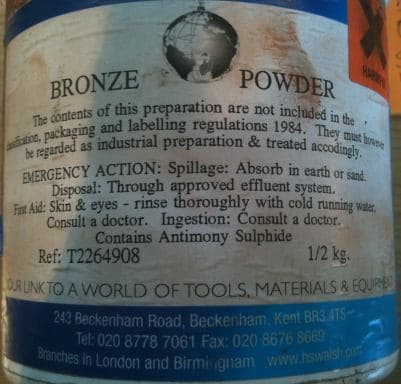

Can anyone help me with a formula to make an equivalent powder?
Thank you so much, in advance.
- Bristol, Avon, England
April 22, 2013
Q. Hi Mr Jacobs
We are a signmaker facing the same problem sourcing for the bronze powder used to tarnish brass.
May we know have you found another supplier other than Walsh?
Would appreciate it if you can share.
Thank you!
- Singapore, Singapore
July 12, 2013
A. I am currently using ammonia to darken a brass piano leg caster and it appears to be working. I've only had it outside in a sealed bag for about 24 hours. It hasn't reached the desired darkness yet but seems to be getting there. The first thing I had to do was remove the lacquer finish. I bought some finger nail polish remover as it contains acetone but it did not remove the lacquer, only seemed to etch it slightly. Having used it however, did make it easier removing the lacquer with sand paper. Once that was done, I put some ammonia in a disposable plastic storage bowl, used the lid to hold the caster and placed both into a small plastic garbage bag which I tied shut. Don't expect immediate results for a dark color using this method.
Carolina Whitten- Columbia, South Carolina, USA
October 9, 2013
Darkening a Brass Chandelier that has heavy Green Patina

Q. I just purchased an old chandelier which appears to be brass. It has a heavy patina on it and I would prefer a darker color.
Is there any way I can achieve this other than spray painting it?
Selena Norris- Atlanta, Georgia
February 1, 2014
A. Hi Selena. I find that to be quite an attractive chandelier and hate to see you mess with it. But the first thing to find out is whether it's actually brass. If it's magnetic, it's not brass, and is at best brass plated -- which probably will not stand up to the darkening chemistry. If it's not magnetic, it could of course be aluminum or zinc; but you may be able to sense whether it's aluminum just from the light weight. If you're pretty sure it's brass, then this thread has worthwhile ideas for you. Good luck.
Regards,

Ted Mooney, P.E.
Striving to live Aloha
finishing.com - Pine Beach, New Jersey
February 2014
How to darken brass without immersion
Q. Hello all,
I have learned so much from reading this thread! I would like to darken (to an almost black color) some brass lamps that I found. I have determined that they are in fact brass and have removed the clear coat on top using acetone
⇦ this on
eBay
or
Amazon
[affil links] Warning! highly Flammable!
and some scrubbing. I have looked into many of the brass darkening solutions
⇦ this on
eBay
or
Amazon [affil links] on here, which would definitely work, but I would need a LOT of the solution to completely cover and soak each lamp as they are not small objects. I am wondering if it would still work if I used the solutions on a rag and rubbed the lamps or if there is some other technique for larger objects that I am not finding.
Thanks!
-Abby
- Raleigh, North Carolina, United States
January 28, 2015
Q. Hi. How can I remove a lacquered brass coating on a solid brass faucet that has a PVD coating? I have tried Acetone and lacquer thinner ⇦ this on eBay or Amazon [affil links] Warning! flammable! and now a spray paint stripper with no luck.
Heather Ezyk- East Longmeadow
January 31, 2015
A. Good day Heather.
I have some experience with electrophoretic lacquers and the stripping of the coating. I used a stripper which contained methylene chloride (which strips epoxy) and formic acid. (Atotech/Aquatone PS 400).
This stripper "softens" the coating, requiring mechanical removal of the coating with a brush, in a bucket of water.
This stripper requires a "layer" of water on the surface to prevent evaporation of the methylene chloride.
Great care must be taken with the stripper, as the formic acid is EXTREMELY corrosive. A splash on exposed skin will produce a burn/blister instantly.(Formic acid is the chemical which fire ants produce!)
I strongly recommend the highest degree of personal protection(when using any corrosive chemical) as a full face shield
⇦ this on
eBay or
Amazon [affil links]
, activated carbon respirator
⇦ this on
eBay
or
Amazon [affil links]
, arms length rubber gloves
⇦ this on
eBay or
Amazon [affil links] .
Any chemical can be dangerous, but with the proper PPE, you can minimize the risk.
I hope I didn't alarm you.
Best wishes.
Regards,
Aerotek Mfg. Ltd. - Whitby, Ontario, Canada
A. Not to throw a wrench into your plans, but we PVD coat brass faucets on a regular basis and they are never lacquer coated. That is one of the great advantages of the coating -- it is pretty much a lifetime finish. You may be trying to strip the PVD coating off of the surface. I say this because PVD coatings are pretty much impervious to the chemicals you have used. PVD coatings can be stripped off, but it requires special chemicals in heated tanks in a properly vented facility. It is not done in situ. To add to the problem, you need a different chemical to strip a Ti-based PVD coating than you do for a Zr- or Cr-based PVD coating.

Jim Treglio - scwineryreview.com
PVD Consultant & Wine Lover
San Diego, California
February 10, 2015
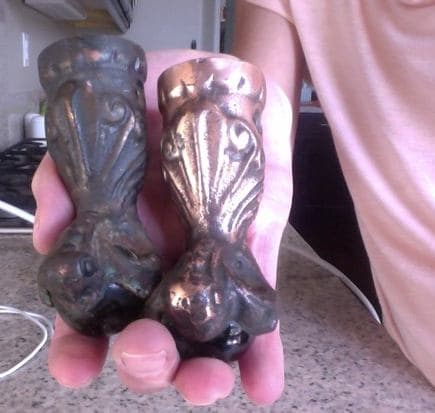
Q. I have 4 cast iron, brass plated steel piano stool claw feet, with glass balls. Two of which have been rubbed with Stripper X and steel wool. This has removed the dark black vintage patina and has exposed the brass which is shiny, and in some spots the silver steel is showing through. The other 2 feet have not been messed with.
My question is this: Is there any way to get the 2 feet that have been stripped to look like they did before they were messed with, so they match the other 2 feet that were not touched?
I have read through the posts in this thread and I'm wondering if the ammonia method in a plastic bag will work or is there something better?
Thanks in advance!
- Temecula, California USA
March 3, 2015
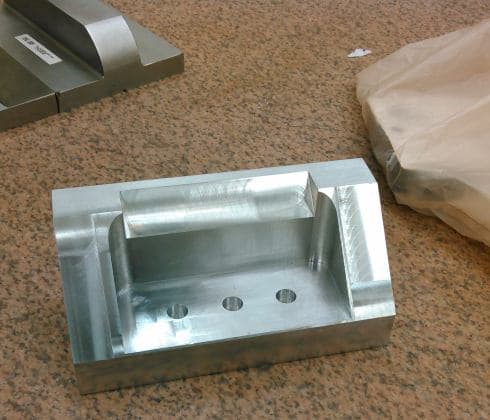

Q. Hi my name is Matthew. So the situation I am faced with is this. I am making a machined Alum holder to display my fathers three shells from his 21 gun salute. On this holder will be 4 engraved placards that will contain his information. I need these to be Black prefer flat black so that when they are engraved the brass coloring shows through. So my questions. Which material Brass, Bronze or Copper and what process? Originally I was going to have the alum holder anodized black but from what I can find out Brass cannot be anodized. So to keep everything looking the same will hopefully use the same process as the other metals for the aluminum.
Thanks for your help in advance,
Matthew Rjust me lol - Arizona
March 4, 2015
A. Hi Matthew. If you look at trophies you'll see that they are usually brass colored with engraved black lettering; high school rings will be gold on the raised areas and black in the recesses; jewelry too, and oil-rubbed items will be bright on the raised areas and dark in the recessed areas. This convention is because raised and exposed areas tend to wear and get shiny whereas recessed areas tend to retain their blackening and accumulate oxidation and dirt. For that reason I'd suggest that you entertain the possibility of perhaps making the placards brass colored with black engraving instead of the reverse. Further, it's hard to make different metals like brass and aluminum match by coloring them black or any other color because they have a different grain, texture, etc., and the colors will look different in different light (black anodizing is actually either very very dark blue or very very dark red). So I think you'll get a better match and more natural look with brass placards to match the shells -- but it's a matter of taste and I don't claim to have much.
The aluminum probably needs to be anodized and dyed black whereas the brass probably needs treatment with selenium dioxide as described in this thread. Good luck.
Regards,

Ted Mooney, P.E. RET
Striving to live Aloha
finishing.com - Pine Beach, New Jersey
March 2015
A. Wynnie and Matt, the solutions you seek are the same. The process is a chemical which turns the copper element in each of your metals from a light brown through to a dark black when used with heat. Then apply lacquer and wax. Matt, your process is to dip the brass plaques into our chemical till black then application of vinyl film (letter mask) you will then get letters etched at trophy shop.
adv.
Call us at BarrysRestoreItAll if you need more info.

Barry Feinman - Chief Restoration Officer
BarrysRestoreItAll
Carlsbad, California

April 5, 2015
A. I might be a little late with the addition to this thread as I was researching something else and stumbled across this - I know that Bronzing Powders are short on supply but know that Access Chemicals Ltd in Tamworth, UK sell Brown Bronze Powder for "brush on" application as described above. It's a niche market and only a few manufacturers produce this product now. Apologies if this is of no use.
Richard Clarke- Coalville, Leicestershire, UK
May 14, 2015
! I just stumbled onto this page through a google search and this may be way outdated but I found so much great information on here. I am working with Bronze and Brass sheet metal and tried some of these tips to get the right finish and found the Liver to work best. I thought I'd pass on a tip: I purchase my raw metals from a local company with good pricing and real nice people to deal with, Widener Metals in PA. I just wanted to try to return the favor. Thanks guys for the tips!
Thomas Tingle- Levittown, Pennsylvania
July 9, 2015
![]() Hi Thomas. Thanks. We'll have to see how it goes since commercial testimonials on this no-registration-required, largely anonymous, site often go south very quickly :-(
Hi Thomas. Thanks. We'll have to see how it goes since commercial testimonials on this no-registration-required, largely anonymous, site often go south very quickly :-(
Regards,

Ted Mooney, P.E. RET
Striving to live Aloha
finishing.com - Pine Beach, New Jersey
July 2015
A. I ran out of the chemicals I've used to do this in the past. Came across this thread while searching for a household solution to the problem. Couldn't find what I was looking for so I started experimenting. I quickly discovered that a mixture of hydrogen peroxide & white vinegar ⇦in bulk on eBay or Amazon [affil links] works great! My hinges have been soaking about an hour now and look better than the ones I've done before. Keep in mind, these were raw brass, it won't work if they're lacquered.
A. Desiderio- Downingtown, Pennsylvania USA
July 12, 2015
Q. I have 2 copper sinks in a bathroom and one, being used more than the other, has lost a lot of it antique brown finish. Will the Palmolive dish soap technique work on this or should I go with something else? Also, once I get the color finish I want, how do I keep it since both sinks are used on a daily basis?
Thank you!
- Seymour, Tennessee, USA
August 25, 2015
A. Gail, great questions. The patina created on copper sinks is beautiful but fragile. Harsh chemicals and abrasive scrubbing will remove this finish.
adv.
A repair kit which we created to resolve issues like yours will quickly restore your beautiful finish. We also give you a hardy brown wax which will help protect your finishes. Frequent application of our wax will keep it looking its best. A call to our offices and we will help anyone with solutions for copper, bronze. and stainless steel

Barry Feinman - Chief Restoration Officer
BarrysRestoreItAll
Carlsbad, California

October 16, 2015
Q. Hey
I have a statue made up of brass. I want to turn this into golden colour with glossy appearance. Which wax and lacquer I should use? Please suggest. Thanks.
- kolhapur Maharashtra India
December 11, 2015
How to make liver of sulfur to blacken brass
Q. Hi, I live in Iran and I have a small job in plating and patina. I need to blacken brass and copper but I can't find liver of sulfur ⇦ this on eBay or Amazon [affil links] here. Can I make by myself or use another solution as well as that. I will be so glad if you help me.
Amir goudarzi- Iran tehran
February 6, 2016
A. Hello cousin Amir. Try enclosing the item is a plastic bag with a crushed hard boiled egg, and tell us what happens. Thanks.
Regards,

Ted Mooney, P.E. RET
Striving to live Aloha
finishing.com - Pine Beach, New Jersey
February 2016
A. Try this download free metals colouring and cyanide-free plating handbook ( 0 $!):
Hope it helps and good luck!
- Zagreb,Croatia
February 9, 2016
Q. I used the Birchwood Casey Perma Blue
⇦ this on
eBay or
Amazon [affil links] to get a dark patina on 385 bronze. It worked great. This was after trying liver of sulfur without much success. My question is should I now apply a clear coat lacquer? Or will it maintain the patina without the coating. The material is being used as a trim between a existing backsplash and new black granite counter.
Thank you
- Carlstadt New Jersey USA
February 17, 2016
Q. Once I am finished changing my shiny brass patio door levers to an oil rubbed bronze finish, don't I need to apply a permanent protective coating or lacquer to the metal? They are used daily and exposed to the elements. If so, what would I use? Thanks
Jane Lockwood- Plainwell Michigan United States
August 31, 2016
A. Researching historical metal processes, I came across the following 19th century references on Google Books for bronzing formulations. While modern products may be more efficient, those wishing to replicate the old finishes will hopefully find these helpful.
https://books.google.com/books?id=JsNEAQAAMAAJ&pg=PA354
https://books.google.com/books?id=XgshBQAAQBAJ&pg=PA149
https://books.google.com/books?id=tIcPAAAAQAAJ&printsec=frontcover#v=onepage
The last is a French treatise with several formulations for the famous French green bronze coating. You can copy and paste into Google Translate.
- Carlisle, Pennsylvania USA
April 19, 2017
![]() Thanks for the great references Craig!
Thanks for the great references Craig!
The French book displays as pictures of text, rather than as cut&paste-able text; I do see a way of translating it (first download the book as plain text, then copy and paste the plain text into translate.google.com), but if someone knows a simpler way we'd like to post it. Thanks again!
Regards,

Ted Mooney, P.E. RET
Striving to live Aloha
finishing.com - Pine Beach, New Jersey
April 2017
Q. Hi, We purchased this Weslock handle in the oil rubbed bronze,however did not realize this had more red tones that would not match our door. What is the easiest way to darken this to a more bronze/brown color? Will using Palmolive work? Thank you...
Peggy leung- Torrance, California
January 31, 2017
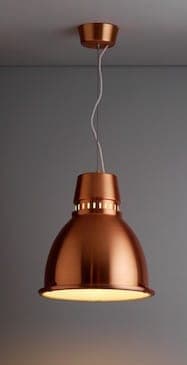
Q. Hi, - dublin, ireland March 26, 2017 A. Hi Clara. As you already recognize, this lamp is made of aluminum. Therefore, the chemical methods which are the subject of this thread won't work because there's no copper, brass, or bronze for the chemicals to react with. You can either paint it or apply a wax rub ( ⇦ this on eBay or Amazon [affil links] ) or "paint on" a patina (a liquid which has the oxidized copper you seek). My experience with the wax rubs is that they are okay if the surface is not a touchable one, which seems to be the case here. Good luck. Regards,  Ted Mooney, P.E. RET Striving to live Aloha finishing.com - Pine Beach, New Jersey April 2017 |
Q. I recently bought a bronze vase its 19th century but it looks like brass how do I get the dark patina back on it? Many thanks in anticipation.
Mark
- Leeds Yorkshire england
June 14, 2017
Q. I have blackened brass cabinet hardware that the blackening has worn off, especially the handle on the refrigerator. How can I get the blackened appearance back? I was going to try liver of sulfur and than lacquer them again, but is there any other process I can do?
Cher Eppingawomens touch paint and design - Evergreen, Colorado
July 13, 2017
Q. Very interesting thread and happy to keep it running. I vape an e-cig which is full copper for it's conductivity. Being a bit picky I prefer a darker coloured copper than the bright finish I have now. My question is simply can I safely darken the copper whilst keeping it shiny? And is it a process that needs to be regularly repeated. I'm UK based so would have to use something considered 'safe'.
Again, interested in a lot of what I've read here (and found by accident!!).
- Manchester, UK
August 25, 2017
Q. I just bought a vintage dark brown distressed leather sofa that has hundreds of brass nail heads way too shiny for our taste. How do I darken them, without taking them off or damaging the leather. Thanks in advance for any advice.
Letty dupree- Atlanta, Georgia USA
November 2, 2017
A. Hi Letty. That's really not so much a technical question (because you've already read that liver of sulfur, brass darkening solution, and several other materials will darken brass), as a question of whether you have the time & temperament, and the steadiness of hand to carefully apply it to "hundreds of brass nail heads" with an artists brush, covering each completely, without getting it on the leather. Further, if they're bright, they probably have a lacquer on them which you'd have to remove the same way first. There's an old saying that you'd need the patience of a saint.
Or just tape the open end of a plastic sandwich with a crushed hard boiled egg in it over one of the nail heads overnight and tell us what, if anything, happens. Good luck.
Regards,

Ted Mooney, P.E. RET
Striving to live Aloha
finishing.com - Pine Beach, New Jersey
November 2017
How to darken copper but not brass
Q. Hi ... thanks for a great thread. I just recently made a patterned (Mokume Gane) metal surface with copper and brass. I had been searching for a way to darken the copper but not the brass. The only thing I have found is by using a heat patina. Can the brilliant contributors here suggest a chemical solution? Thanks so much!
~Barbara
- South Berwick, Maine
November 6, 2017
A. Hi Barbara. I don't know what the article in question is, but can you try Rokushno patina on it and see whether it offers suitable/any contrast? Or maybe you can darken the whole thing and burnish/relieve the brass?
Regards,

Ted Mooney, P.E. RET
Striving to live Aloha
finishing.com - Pine Beach, New Jersey
November 2017
Q. Hi along these lines, I just had some medals cast in bronze and they are much lighter than my other medals which look aged and dark brown. Does Palmolive darken bronze too? Thanks!
Jean Mark- Sacramento, California USA
July 25, 2018
adv.
Hello all ... yes we have such a chemical patina which is sold in kit form to do just this. Please find our Copper Patina Rescue kit at www.barrysrestoreitall.com. We offer two sizes based on area. Quick and easy to use. Using a hairdryer will speed up the process to dark. Good luck.

Barry Feinman - Chief Restoration Officer
BarrysRestoreItAll
Carlsbad, California

November 9, 2018
Restore graduated blackening on bronze bowl
Q. I have a patinated bronze bowl, the natural colour of which is amid yellow brown, graduated brown to deep black -- but the colour appears to be flaking but without thickness and its spoiling its appearance. I would like to revive and restore its beauty but graduation is going to require the right chemicals, preferably cold and carefully sprayed. Any suggestions and tips would be gratefully received. Thanks,
Ron MartinRetired, Collector - Buckhurst Hill Essex UK.
September 6, 2019
January 4, 2020
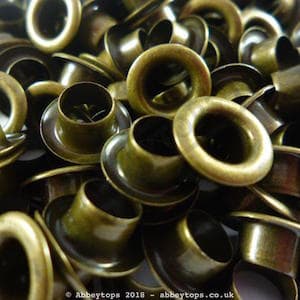
Q. Hi everyone.
I'm in need of a technique to antique brass plating and I'm stuck. I have been given some eyelets by a customer and I need to try and match the colour as closely as I can (I have attached a picture of the colour I'm trying to match). I have tried antiquing fluid in the past but this just strips the plate and nowhere seems to sell antique brass as a plating fluid.
I assume I need a blackener of some kind but I'm really not sure which would give the best result (I'm not an expert).
Please can anyone help.
Many thanks, Nik.
Hobbyist/Sole Trader - Doncaster, UK
A. Hi Nik. On the one hand plating shops antique brass and copper plating routinely; on the other hand, the sellers of brass darkening solutions warn you to use them only on solid brass, not plated brass, and your experience supports that warning :-(
I think the thing to do is to apply a tinted brass lacquer. See, for example, this page from G.J. Nikolas [a finishing.com supporting advertiser]: http://www.finish1.com/page_products_dyecolors.htm
Good luck & Regards,

Ted Mooney, P.E. RET
Striving to live Aloha
finishing.com - Pine Beach, New Jersey
January 2020
Q. Hi Ted!
Thanks for that. Ah the USA, I wish they had a stockist in the UK. I will keep checking around and see what I can find. I assume something like Birchwood Brass Black
[Brass Black on
eBay or
Amazon [affil links]
wouldn't work then as it's plated rather rather than solid. Many thanks for the help!
Narrowed Visions - Doncaster, UK
January 9, 2020
A. Hi again. The instructions say to use only on solid brass, but I do not have any personal experience to say it can't succeed :-)
Have you tested the eyelets with a magnet or otherwise determined that they are not solid brass?
Regards,

Ted Mooney, P.E. RET
Striving to live Aloha
finishing.com - Pine Beach, New Jersey
January 2020
![]() Oops, sorry for the delay. The things I'm looking to do are brass underneath but they are plated in zinc/nickel. I could remove that but its a bit of a lengthy process for something that I can't charge much for (the eyelet image was just to illustrate the colour required). I may have a play and see if I can work it out. Someone suggested plating a thicker layer of brass to counteract the effects of the antiquing fluid. I may just go with powder coating them a similar colour in the end if all else fails. Bah! Thanks for your help so far, I really appreciate it!
Oops, sorry for the delay. The things I'm looking to do are brass underneath but they are plated in zinc/nickel. I could remove that but its a bit of a lengthy process for something that I can't charge much for (the eyelet image was just to illustrate the colour required). I may have a play and see if I can work it out. Someone suggested plating a thicker layer of brass to counteract the effects of the antiquing fluid. I may just go with powder coating them a similar colour in the end if all else fails. Bah! Thanks for your help so far, I really appreciate it!
Narrowed Visions - Doncaster, UK
January 16, 2020
Q, A, or Comment on THIS thread -or- Start a NEW Thread